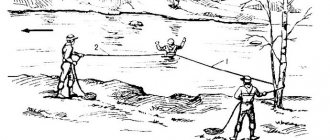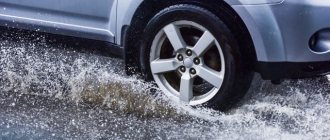Swamps are a very dangerous place that is not to be trifled with. If you are not sure that you can overcome it, you cannot take risks. The swamps and quicksands that the swamp hides are extremely dangerous. This article will give you an idea about overcoming a swamp.
It must be remembered that the speed of movement in the swamp is very low, and the loss of strength is very, very high.
Attention! If it is possible to bypass the swamp, do so. And
Swamps can be divided into several types:
- Impassable
- Passable
- Difficult to pass
How to distinguish a passable swamp from an impassable one?
Swamps are divided into:
- Raised swamps
- Lower swamps
raised bog
very dangerous swamps, they are also called swamps. They are formed due to the growth of old reservoirs.
Such swamps usually have several covers lying on top of each other
- Slavina - peat cover
- Zybun - semi-liquid base, gelatinous (quagmire)
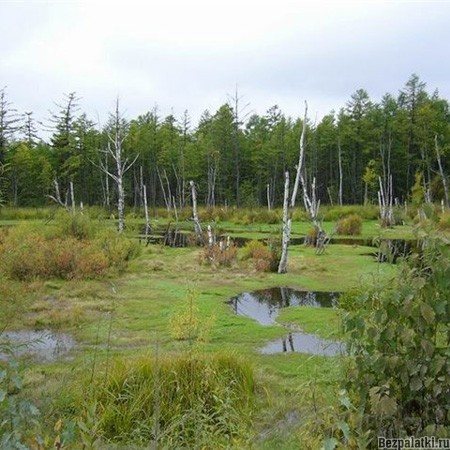
Such swamps are extremely dangerous. This type of swamp is most often impassable. The passability of such a swamp can be determined by its treelessness. In such swamps there are stunted trees or bushes, but the most important sign of a raised (quick) swamp is that when you step on it, it seems to begin to oscillate (the top layer of peat moves)
Bottom swamps
Not so dangerous. Such swamps are usually found in coniferous swampy forests. The maximum you can do is get your clothes or shoes wet. There are many hummocks, islands and trees in such swamps. In other words, these swamps are passable.
How to determine the degree of passability of swamps
Impenetrable swamps
It is impossible to pass through a swamp if it is overgrown with reeds or pieces of peat are floating in the swamp. Do not venture into raised swamps, it can be very dangerous. It is almost impossible to get out of such a swamp.
Difficult swamps
If among the moss in the swamp there are hollows (swamps with stagnant water) If the swamp is overgrown with dense bushes (willow, alder, birch).
cotton grass
Cotton grass grows in the swamp. There is a sign that the thicker the grass, the worse the quagmire to be under it.
The swamp is covered with dense bushes or small trees filled with water, the water (stagnant) stands at the surface, there are individual moss hummocks near the tree trunks. (Such a swamp is overcome from hummock to hummock from tree to tree)
Passable swamps
The swamp is overgrown with pine or birch forest, has a thick grass cover, there are hummocks near the tree trunks, and water on the surface.
The swamp is easily passable if there are tall trees and large hummocks.
There is a lot of windfall in the swamp, a medium-density forest grows, hummocks around the trees, water on the surface or below. This swamp is passable.
Attention! Don't get into the rafting. It's better to go around a few kilometers. You can only move on thick rafting, and then only with great caution.
The so-called charus (overgrown lakes-wells) are extremely dangerous. They meet in the forest. When going into the forest, take a tourist first aid kit with you.
Survival in the swamp
The swamp is one of the harshest places where a person has to survive. The difficulty of surviving in a swamp lies in a whole complex of problems: difficult terrain; an abundance of dangerous animals and other living creatures; dominance of vileness; high humidity; difficulties with dry fire materials and starting a fire; shortage of water suitable for drinking; difficulty obtaining food; toxic fumes; It's difficult to find a normal place to rest. Today we will talk about how to solve all of the above problems and effectively survive in the swamps .
Swamps are different. But, as a rule, in vast swampy areas there are not very swampy, quite passable areas, an impassable, deadly quagmire and quite dry, raised areas with vegetation and trees. Usually, all these types of sites are mixed. The task is to choose a route along passable and dry areas, avoiding bogs. Dry areas are identified by the elevation of the terrain and the presence of trees. Willow bushes can grow close to the bog, but tall trees, alder and especially pine, indicate at least a small area with solid ground. Marshes are defined by an almost complete absence of vegetation, sparser hummocks and a visible sinkhole. Walking through a swamp, you need to test the soil in front of you with a strong long pole and try to jump from hummock to hummock. If you still fall into a quagmire , use a special technique to get out.
When walking through a swamp, you should try to stop periodically to dry your shoes and air your feet. From constant exposure to swamp slurry, so-called sore throat may form on your feet. "trench foot" You will not be able to move, which means you will die.
dangerous animals live in swamps . The danger comes from poisonous snakes, leeches and especially clouds of midges . It won't seem like much if you run into a crocodile or a beaver defending its territory. In order not to run into snakes, you must try to control every step and try to create more noise. Examine yourself periodically, and if you find leeches attached, remove them. For huge clouds of midges, it helps to smear exposed skin with swamp mud or beaver feces. If possible, during a halt you need a fire and a smoke pipe to drive away midges and mosquitoes.
There is little firewood in the swamp . But rest stops, as a rule, are arranged if there is a relatively dry area, and there may be trees, some of whose branches are dry. Also, in the swamps you can get dry peat - an excellent combustible material for a fire. The peat must be cut where it rises in mounds above the swamp and is sufficiently dry. The peat from the lower layers is too wet, and you will have no time to dry it.
Swamp water should not be drunk . You need to try to find a clean spring, lake or river, which often borders swamps. The water must be filtered several times through cloth and carbon filters, and also boiled.
In the swamps you can eat snakes if you can catch and kill them. You'll be lucky if you come across a turtle. You can also hunt small crocodiles, nutria, muskrats, and beavers. It is difficult to fish in the swamps themselves. But swamps often border on quite serious lakes and rivers. This is where you can fish effectively. Various insects, shellfish, roots, fruits, and berries of some marsh plants are also eaten. For example, the succulent roots of cattail and sedge are good.
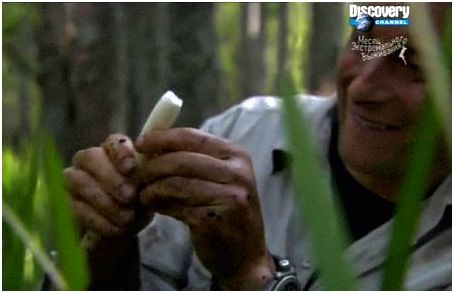
from toxic gases in swamps by wearing a simple bandage on your respiratory tract (cover your mouth and nose).
A place for camping and spending the night should be chosen on a hill where it is dry. If there are no such places, then you can find a more or less durable, spreading tree and build a bed on it. If only the place where you will sleep is raised above the swamp slurry by a meter and a half. There, on a platform that you make from branches, you can make a fire to stay warm, dry, cook food, and at the same time scare away midges and wild animals that are especially active at night.

Techniques for moving through the swamp
- Cut the pole, check the area with the pole before stepping on it.
- Move from hummock to hummock, avoid thickets of cotton grass (see above).
- Try to avoid wetlands.
- If you are moving in a group, the distance from each other should be no more than 2-3 meters.
- If you are walking along a raft (not recommended), then keep a distance of 5 meters, otherwise the raft may not hold up and break through.
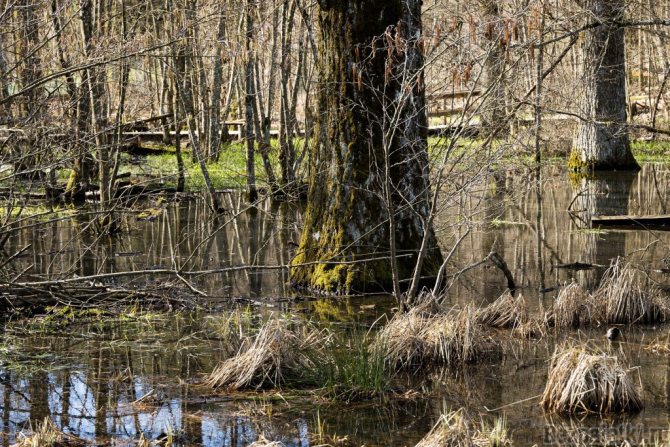
How to get out if you find yourself in a quagmire
Do not panic and do not make sudden movements, gradually and measuredly begin to get out, if you are walking in a group, then shout for a rope or pole to be thrown to you.
If you are alone, then when you fall through, place the stick across and gradually transfer your body weight onto the stick, leaning on it with your chest.
If you have a backpack on your shoulders, remove it without sudden movements. Next, place the stick in front of you and smoothly pull yourself towards it.
If you managed to crawl out of the quagmire, do not rush to get up, crawl away from the dangerous place (a lying person has a larger area and less pressure on the ground). Leave where you came from.
But if there is no urgent need, it is better to avoid the swamps.
Swamps. Overcoming swamps. Safety precautions
Not only the homeland of mosquitoes: why swamps cannot be drained and how this threatens the planet
Why are wetlands important?
Wetlands act like giant sponges: when heavy rains lead to flooding, they absorb excess moisture when storms occur, protecting the coastline from erosion and destruction.
On the other hand, wetlands are a natural wastewater treatment plant. When excess nitrogen and other chemicals wash into marshes, marsh plants absorb and process them. Most of these chemicals are the result of human activity: agriculture, which uses fertilizers containing nitrogen and phosphorus, as well as factories, water treatment plants and households.
If plants cannot process the chemicals from the wastewater, they slowly sink to the bottom, where they are stored under a layer of sand and silt.
For many centuries, humanity was not aware of the importance of wetlands for the ecosystem - they were perceived as useless areas from the point of view of construction or agriculture, which were suitable only for the breeding of insects that carry various diseases, such as mosquitoes.
China began large-scale drainage of wetlands in 486 BC. e., when he began construction of the Grand Canal, which is still the longest canal in the world. The Dutch began draining wetlands on a large scale about a thousand years ago, but many have recently been restored. The first US President, George Washington, personally oversaw the failed draining of the Great Dismal Swamp on the Virginia-North Carolina border. Today, many modern cities around the world are built on filled wetlands, and wetland drainage continues in some Asian countries
Meanwhile, one type of wetland, peat bogs, which make up just 3% of the earth's surface, stores twice as much carbon as forests.
Over the course of several thousand years, both peatlands and swamps accumulated huge reserves of carbon dioxide and methane, the main greenhouse gases. If wetlands did not remove them from the atmosphere, carbon dioxide concentrations from human activity would increase by 28% every year.
What's happening to the swamps?
Despite their important role in global climate regulation, wetlands remain undervalued. About 35% of the world's wetlands were lost between 1970 and 2015, and the loss rate has increased annually since 2000.
The reason for the drainage or sharp reduction of water in swamps is the so-called megatrends, including climate change, population growth, urbanization, changing consumption patterns and, as a result, the influence of agriculture.
The wetlands, which have until now remained relatively stable, are at risk of destruction due to unsustainable land use for agriculture, invasive plant and animal species, loss of water due to the construction of dams and dams, deforestation and soil erosion.
In addition to filtering pollutants and collecting greenhouse gases, wetlands provide, directly or indirectly, almost all of the world's freshwater consumption. They are also some of the most biodiverse ecosystems. Up to 40% of the world's species live and breed in wetlands. Due to the draining of swamps, more than 25% of all plants and animals that live in them are currently in danger of extinction.
Forest areas are declining around the world, with this trend especially noticeable in the tropics. In the first 13 years of this century, the area of intact forest worldwide fell by 7% - more than France and the UK combined.
According to a report by the Intergovernmental Science-Policy Platform on Biodiversity and Ecosystem Services (Ibpes), 85% of the world's wetlands have disappeared since 1700.
An international team of scientists has found that human activities such as drainage, deforestation and livestock grazing have caused significant damage to more than 40% of peatlands in Europe over the past 200 years.
The researchers studied 31 peatlands in the UK, Ireland, Scandinavia and continental Europe and, based on rhizopod analysis - based on the remains of testate amoebae in the peat layers - estimated the surface moisture level of these ecosystems. It turned out that 20% are in the least hydrated state in the last 2,000 years.
“Global drying of peatlands could transform these ecosystems from a carbon store to a source, which could lead to increased concentrations of greenhouse gases in the atmosphere and therefore increase climate warming. Now more than ever, it is important to preserve peat bogs - unique ecosystems that are a valuable mechanism for regulating climate on our planet,” commented Yuri Mazei, professor at Moscow State University and lead author of the study, on the study.
What measures are being taken?
Scientists estimate that wetlands currently occupy more than 12.1 million square meters. km is larger than the area of Greenland. Of these, only 13–18% (2,300 sites) are included in the Ramsar list of wetlands, that is, they are under protection.
The Ramsar Convention is a treaty ratified by 170 states, including Russia. The purpose of the convention is the conservation and wise use of all wetlands through local, regional and national action and international cooperation, as a contribution to achieving sustainable development throughout the world. As of 2019, it covers 307 wetlands of international importance with a total area of 228.9 million hectares.
At the same time, the Ramsar Convention does not take into account the processes that occur with wetlands due to climate change. The Paris climate agreement does not have a separate article on wetlands: it only talks about forests, which countries party to the agreement call on to protect and restore.
The UN also does not pay enough attention to wetland violations. The project, called Reducing Emissions from Deforestation and Degraded Forests, or REDD+, funds developing countries to protect only existing forests, prevent deforestation and restore degraded forests.
Although the initiative addresses forested wetlands and mangroves, a voluntary provision for reporting emissions from wetlands was only introduced into the UN climate accounting system in 2020. So far, only a few countries are reporting data on this issue.
Nowadays, swamps are often drained rather than preserved. At the same time, the eradication of wetlands also threatens economic activity. Two-thirds of fish and shellfish harvested commercially worldwide are associated with wetlands. From the Brazilian warza, or freshwater marshes, surrounding the Amazon River to the salt marshes near the Florida Keys, commercially valuable fish species are in danger of extinction.
